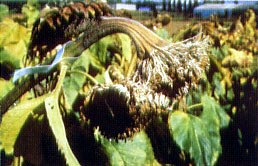Diseases
Sclerotinia sclerotiorum (Lib.) de Bary (=Sclerotinia libertiana Fuckel., =Whetzelinia sclerotiorum (Lib.) Korf and Dumont) - White Rot of Sunflower.
Systematic position.
Class Ascomycetes, order Helotiales, family Sclerotiniaceae, genus Sclerotinia.Biological group.
Facultative parasite.Morphology and biology.
The life cycle of S. sclerotiorum is characterized by the formation of exophitic septate mycelium, sclerotia of various sizes, microconidia and the reproductive bodies, apothecia. Apothecia are formed on sclerotia in the shape of elevated rounded formations widening upward. Asci with ascospores are located in stroma. Mycelium and ascospores cause infection of plants. Microconidia function as spermatozoons during the perfect stage. Sclerotia ensure the persistence of the pathogen and its inoculation renewing during vegetation of plants. The pathogen attacks all parts of the sunflower including roots, stems, leaves, and flowers. The most harmful form of the disease is flower infection. A 5% infection rate of sunflower heads or stems results in economic loss. The disease develops only before the sunflower begins flowering. After flowering, but before seeds mature, the pathogen reaches maximal growth. Inside the affected tissue or less often on tissue surface, compact black sclerotia are formed, which is a characteristic of the disease.Distribution.
White Rot of Sunflower occurs in Russia and other countries of the former USSR. The greatest damage is observed in the Central Chernozem Zone and Northern Caucasus areas in Russia, and the forest-steppe zone in Ukraine and Moldova. In these areas, epidemics of the White Rot of Sunflower take place 3-4 times per 10 years.Ecology.
The causal agent of White Rot of Sunflower (S. sclerotiorum) is maintained in soil and plant debris in the form of sclerotia, and as mycelium in infested seed. From sclerotia, four or more generations of apothecia with ascospores can be generated under optimal conditions during the vegetative period of sunflower. Optimal mass infection of flower heads, leaves, and the upper half of sunflower stalks takes place at high humidity and air temperatures ranging from 15.C to 20.C; corresponding to an HTC index (Hydrothermic Coefficient) of 1.3 or more (Selyaninov, 1928). At HTC 1.3 or less, infection of roots and base of sunflower stalks occurs mainly by fungal mycelium. The disease is depressed when HTC does not exceed 0.5. Continuous wetness of soil and air are the main factors promoting infection by the pathogen. If the heads remain wet for 42 h under optimal temperatures, mass infection takes place.Economic significance.
Mass outbreak of White Rot can cause sunflower crop losses of 60% and more. Control measures against White Rot include optimal crop rotation, the use of tolerant varieties and hybrids, chemical seed dressing prior to sowing, fungicide treatment of growing plants, and preharvest desiccation.Related references:
Adams P.B., Ayers W.A. 1979. Ecology of Sclerotinia species. Phytopathology 69(8):896-899.Lamarque C. 1983. Climate conditions necessary for affection of sunflower by Sclerotinia sclerotiorum: local forecast of epidemics [Conditions climatiques necessaires a la contamination du tournesol par Sclerotinia sclerotiorum: prevision des epidemies locales]. Bull. OEPP 13(2): 75-78. (In French)
Selyaninov G.T. 1928. About agricultural estimation of climate. Proceedings on agricultural Methodologies, Issue 20: 169-178. (In Russian)
Tikhonov O.I. 1975. Diseases of sunflower. In: Pustovoit V.S., editor. Sunflower. Moscow: Kolos. 401-409 pp. (In Russian)
Yakutkin V.I. 2001. Diseases of sunflower in Russia and their control. Zashchita i karantin rastenii N.10: 26-29. (In Russian)
Yakutkin V.I., Milyutenkova T.I. 1990. Forecast of White Rot and Gray Mould of sunflower for optimization of the protective methods. The methodical recommendations. St. Petersburg. 17 pp. (In Russian)
Yakutkin V.I., Milyutenkova T.I. 1991. The account, forecast of White Rot and Gray Mould of Sunflower. The methodical recommendations. St. Petersburg. 36 pp. (In Russian)
Yakutkin V.I., Tavolzhanskii N.P. 1999. Disease control on sunflower in Russia. Research progress in plant protection and plant nutrition. Agro annual meeting, China 99. China Agriculture Press. Beijing. 214-218 pp.
© Yakutkin V.I.


